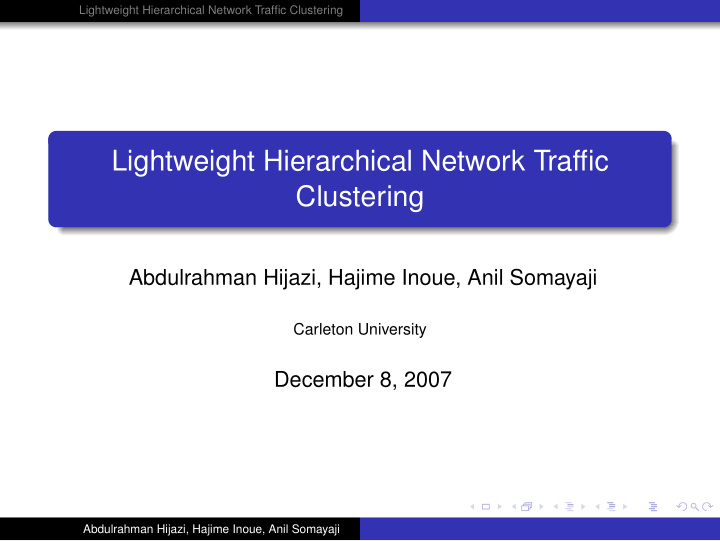



Lightweight Hierarchical Network Traffic Clustering Lightweight Hierarchical Network Traffic Clustering Abdulrahman Hijazi, Hajime Inoue, Anil Somayaji Carleton University December 8, 2007 Abdulrahman Hijazi, Hajime Inoue, Anil Somayaji
Lightweight Hierarchical Network Traffic Clustering Problem Statement The complexity of current Internet applications makes the understanding of network traffic a challenging task. New Applications/Protocols/Attacks appear all the time. Current solutions have limitations: classifiers based on packet header information are fast but 1 fail with unknown protocols and obfuscated traffic protocol dissectors are more accurate but are very slow 2 machine learning past work identifies traffic as belonging to 3 a small set of pre-defined classes Abdulrahman Hijazi, Hajime Inoue, Anil Somayaji
Lightweight Hierarchical Network Traffic Clustering ADHIC: Our Complementary Solution ADHIC (Approximate Divisive HIerarchical Clustering) is a new real-time algorithm that clusters similar network traffic together without prior knowledge of protocol structures. Packet similarity is determined through comparisons of substrings within packets at distinguishing offsets. ADHIC: finds semantically interesting clusters and appropriately 1 segregates well-known protocols, clusters together traffic of the same protocol running on 2 multiple ports, segregates traffic from applications, such as p2p, that do 3 not use standard ports, and adapts to changing nature of traffic patterns. 4 Abdulrahman Hijazi, Hajime Inoue, Anil Somayaji
Lightweight Hierarchical Network Traffic Clustering Why ADHIC? ADHIC is notable in that it produces a hierarchical decomposition of network traffic in 1 the form of a cluster-identifying decision tree, does not assume prior knowledge of protocols and is 2 unsupervised in every stage in operation, needs only a small fraction of packets (about 3% in our 3 traces) to generate a decision tree, and can be used to cluster packets at wire speeds (250 Mbps in 4 an unoptimized software implementation). NetADHICT, our implementation of ADHIC is available at: http://www.ccsl.carleton.ca/software Abdulrahman Hijazi, Hajime Inoue, Anil Somayaji
Recommend
More recommend